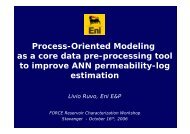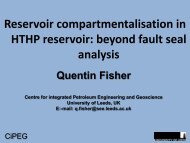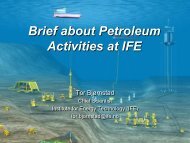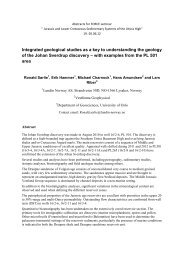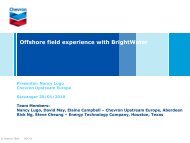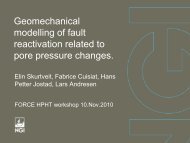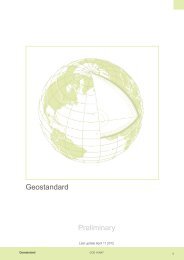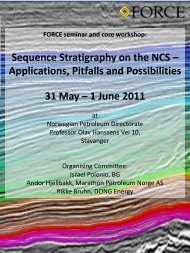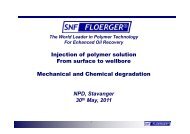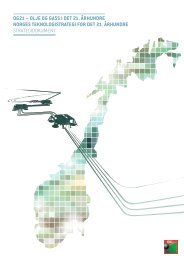How to find field candidates for enhanced recovery by water ... - Force
How to find field candidates for enhanced recovery by water ... - Force
How to find field candidates for enhanced recovery by water ... - Force
Create successful ePaper yourself
Turn your PDF publications into a flip-book with our unique Google optimized e-Paper software.
<strong>How</strong> <strong>to</strong> <strong>find</strong> <strong>field</strong> <strong>candidates</strong> <strong>for</strong> <strong>enhanced</strong><br />
<strong>recovery</strong> <strong>by</strong> <strong>water</strong> additives on the NCS<br />
Enhanced Recovery <strong>by</strong> <strong>water</strong> additives<br />
FORCE Seminar 08. 02. 2007<br />
Jan Bygdevoll, Principal Engineer, NPD
• Why is a <strong>field</strong> a candidate <strong>for</strong> <strong>enhanced</strong> <strong>recovery</strong> ?<br />
• Because there is more oil <strong>to</strong> potentially be recovered than <strong>by</strong> methods<br />
applied <strong>to</strong>day<br />
• What is a method <strong>for</strong> <strong>enhanced</strong> <strong>recovery</strong> ?<br />
• Anything that increase (or enhance) the <strong>recovery</strong> of oil (or gas) from a <strong>field</strong><br />
• Injection methods<br />
• Water<br />
• Gas, including CO 2<br />
• Combination (WAG)<br />
• Additives <strong>to</strong> injected <strong>water</strong><br />
Surfactants<br />
Polymers<br />
Other ?<br />
08.02.07 2
Norwegian Oil production RNB2006<br />
Oljeproduksjon, Norsk kontinentalsokkel<br />
Alle ressurskategorier<br />
200<br />
180<br />
160<br />
140<br />
120<br />
Uoppdagede ressurser<br />
Ressurser i funn<br />
Ressurser i felt<br />
Reserver<br />
Faktisk<br />
Produsert per 31.12.2005: 3,0 GSm3<br />
Gjenværende reserver: 1,2 GSm3<br />
Ressurser i felt: 0,4 GSm3<br />
Ressurser i funn: 0,1 GSm3<br />
Uoppdagede ressurser: 1,2 GSm3<br />
MSm3<br />
100<br />
80<br />
60<br />
40<br />
20<br />
0<br />
1970 1980 1990 2000 2010 2020 2030<br />
M:\Lag\D-RessAnalyse\EKM\Totalprod.xls<br />
08.02.07 3
Oil production – prognosis <strong>to</strong> 2011 (RNB 2007)<br />
200<br />
Ressurser i funn/Resources in discoveries<br />
Ressurser i felt/Resources in <strong>field</strong>s<br />
Reserver/Reserves<br />
His<strong>to</strong>risk produksjon/Actual production<br />
3.0<br />
150<br />
millioner Sm³<br />
million Sm 3<br />
100<br />
2.0<br />
millioner fat per dag<br />
million barrels per day<br />
50<br />
1.0<br />
0<br />
1995 1997 1999 2001 2003 2005 2007 2009 2011<br />
0.0<br />
08.02.07 4
Oil profiles <strong>for</strong> Norwegian <strong>field</strong>s<br />
200<br />
180<br />
160<br />
Rest<br />
140<br />
Balder<br />
120<br />
Norne<br />
Ula<br />
MSm3<br />
100<br />
Draugen<br />
80<br />
60<br />
Oseberg<br />
Heidrun<br />
Troll<br />
Grane<br />
Grane<br />
40<br />
Gullfaks<br />
Snorre<br />
Valhall<br />
Eldfisk<br />
20<br />
Statfjord<br />
Ekofisk<br />
0<br />
1980 1985 1990 1995 2000 2005 2010 2015 2020 2025<br />
08.02.07 5
Status <strong>for</strong> NPD’s goal on Reserve<br />
Growth <strong>for</strong> Oil 2005 – 2015<br />
800<br />
Goal <strong>for</strong> reserve growth<br />
700<br />
600<br />
Prognosis autumn 2004 <strong>for</strong> reserve growth <strong>to</strong>tal<br />
Prognosis autumn 2004 <strong>for</strong> reserve growth in existing <strong>field</strong>s<br />
Cumulative reserve growth in <strong>to</strong>tal<br />
Cumulative reserve growth from existing <strong>field</strong>s<br />
500<br />
Mill Sm3<br />
400<br />
300<br />
200<br />
100<br />
0<br />
2004 2005 2006 2007 2008 2009 2010 2011 2012 2013 2014<br />
08.02.07 6
Status <strong>for</strong> NPD’s goal on Reserve<br />
Growth <strong>for</strong> Oil 2005 – 2015<br />
800<br />
700<br />
Goal <strong>for</strong> reserve growth<br />
Prognosis autumn 2004 <strong>for</strong> reserve growth <strong>to</strong>tal<br />
Prognosis autumn 2004 <strong>for</strong> reserve growth in existing <strong>field</strong>s<br />
Cumulative reserve growth in <strong>to</strong>tal<br />
Cumulative reserve growth from existing <strong>field</strong>s<br />
RNB 2006 Opera<strong>to</strong>rs prognosis<br />
RNB 2007 Opera<strong>to</strong>rs prognosis<br />
600<br />
500<br />
Mill Sm3<br />
400<br />
300<br />
200<br />
100<br />
0<br />
2004 2005 2006 2007 2008 2009 2010 2011 2012 2013 2014<br />
08.02.07 7
600<br />
400<br />
200<br />
0<br />
-200<br />
-400<br />
-600<br />
Produced, yet <strong>to</strong> produce and oil remaining in<br />
ground based on current plans<br />
Ekofisk<br />
Troll II<br />
Eldfisk<br />
Valhall<br />
Snorre<br />
Heidrun<br />
Statfjord<br />
Oseberg<br />
Gullfaks<br />
Troll I<br />
Oseberg Sør<br />
Tor<br />
Gullfaks Sør<br />
Njord<br />
Grane<br />
Vest Ekofisk<br />
Brage<br />
Balder<br />
Kristin<br />
Ula<br />
Draugen<br />
Snøhvit<br />
Oseberg Øst<br />
Norne<br />
Visund<br />
Veslefrikk<br />
Vigdis<br />
Alvheim<br />
Gyda<br />
Tordis<br />
Åsgard<br />
Hod<br />
Remaining oil in ground at planned cessation<br />
Produced oil end 2006<br />
Remaining oil reserves<br />
08.02.07 8<br />
MSm³
Produced, yet <strong>to</strong> produce and oil remaining in<br />
ground based on current plans<br />
600<br />
400<br />
200<br />
MSm³<br />
0<br />
-200<br />
Chalk reservoir<br />
Sand reservoir w/ <strong>water</strong> inj<br />
Sand reservoir w/ gas inj<br />
-400<br />
Remaining oil in ground at planned cessation<br />
Produced oil end 2006<br />
Remaining oil reserves<br />
-600<br />
08.02.07 9
120<br />
100<br />
80<br />
60<br />
40<br />
20<br />
0<br />
-20<br />
-40<br />
-60<br />
-80<br />
-100<br />
Produced, yet <strong>to</strong> produce and oil remaining in<br />
ground based on current plans<br />
Snøhvit<br />
Oseberg Øst<br />
Norne<br />
Visund<br />
Veslefrikk<br />
Vigdis<br />
Alvheim<br />
Gyda<br />
Tordis<br />
Åsgard<br />
Hod<br />
Fram<br />
Statfjord Nord<br />
Embla<br />
Frøy<br />
Albuskjell<br />
Statfjord Øst<br />
Kvitebjørn<br />
Varg<br />
Yme<br />
Tyrihans<br />
Jotun<br />
Glitne<br />
Tambar<br />
Mime<br />
Urd<br />
Volve<br />
Remaining oil in ground at planned cessation<br />
Produced oil end 2006<br />
Remaining oil reserves<br />
08.02.07 10<br />
MSm³
Development in <strong>recovery</strong> fac<strong>to</strong>r<br />
grouped <strong>by</strong> <strong>field</strong> seize<br />
60<br />
Recovery Fac<strong>to</strong>r Oil (%)<br />
50<br />
40<br />
30<br />
20<br />
NB! The number of <strong>field</strong>s varies with time<br />
1992 1993 1994 1995 1996 1997 1998 1999 2000 2001 2002 2003 2004 2005 2006<br />
50 million Sm3 oil<br />
15 - 50 million Sm3 oil Average all <strong>field</strong>s<br />
08.02.07 11
Recovery fac<strong>to</strong>r versus Reservoir Complexity<br />
Index (RCI) – a <strong>to</strong>ol <strong>for</strong> estimating potential ?<br />
0.70<br />
y = -0.776x + 0.7779<br />
R 2 = 0.8095<br />
0.60<br />
0.50<br />
Utv grad<br />
0.40<br />
0.30<br />
0.20<br />
0.10<br />
0.00<br />
0.10 0.20 0.30 0.40 0.50 0.60 0.70 0.80 0.90<br />
08.02.07 RCI<br />
12
Reservoir Complexity Index (RCI)<br />
– parameters used in evaluation<br />
Complexity<br />
attribute<br />
Description<br />
Low complexity<br />
1<br />
2<br />
Complexity score<br />
3<br />
4<br />
High complexity<br />
5<br />
Average<br />
permeability<br />
Describes the pore volume weighted<br />
average permeability in the main<br />
flow direction of the defined<br />
reservoir. mD<br />
> 10.000<br />
1000-<br />
10<br />
00<br />
0<br />
100-1000<br />
10-100<br />
< 10<br />
Permeability<br />
contrast<br />
Describes the permeability contrast<br />
between geological layers/facies<br />
types, and is calculated as<br />
log10[Kmax/Kmin]<br />
4<br />
Structural<br />
complexity<br />
Describes how fluid flow between wells<br />
is affected <strong>by</strong> fault density, fault<br />
throw, fault transmissibility, ….<br />
The fault properties<br />
does not restrict<br />
fluid flow.<br />
The fault properties restrict<br />
fluid flow significantly.<br />
(High density of faults<br />
with throw larger than<br />
reservoir thickness<br />
and/or 'zero'<br />
transmissibility).<br />
Lateral stratigraphic<br />
continuity<br />
Describes the stratigraphic continuity of<br />
the flow units in the main flow<br />
direction within the defined<br />
reservoir<br />
High degree of<br />
continuity<br />
Highly discontinuous.<br />
Difficult <strong>to</strong><br />
predict/describe<br />
injec<strong>to</strong>r/producer<br />
connecting flow units.<br />
STOOIP density<br />
Describes the areal concentration of<br />
STOOIP and is defined as<br />
STOOIP/area<br />
(mill. Sm3/km2)<br />
>4.5<br />
2 - 4.5<br />
1 - 2<br />
0.5 - 1<br />
< 0.5<br />
Coning tendency<br />
Describes the coning problems<br />
associated with a gas cap or<br />
aquifer support. Large complexity<br />
only in cases where the oil band<br />
is thin.<br />
No coning tendency.<br />
Some coning<br />
problems<br />
from gas<br />
cap or<br />
aquifer<br />
Thin oil zone and production<br />
severely restricted <strong>by</strong><br />
gas or <strong>water</strong> coning<br />
problems<br />
08.02.07 13
Important issues in estimating potential <strong>for</strong><br />
different methods <strong>to</strong> increase <strong>recovery</strong><br />
• <strong>How</strong> is the remaining oil distributed in the reservoir?<br />
• Temperature<br />
• Fluid chemistry<br />
• Mineralogy<br />
• Topside facilities and wells<br />
• Cost, both investment and operational<br />
• Remaining <strong>field</strong> life<br />
• Other issues<br />
08.02.07 14
Reservoir temperature in <strong>field</strong>s on NCS<br />
Frigg<br />
Snøhvit<br />
Odin<br />
Troll<br />
Alvheim<br />
Alvheim<br />
Balder<br />
Alvheim<br />
Draugen<br />
Gullfaks<br />
Gullfaks<br />
Gullfaks<br />
Heimdal<br />
Grane<br />
Balder<br />
Gullfaks<br />
Glitne<br />
Tordis<br />
Tordis<br />
Snøhvit<br />
Jotun<br />
Tordis<br />
Heidrun<br />
Skirne<br />
Statfjord<br />
Valhall<br />
Statfjord Øst<br />
Snorre<br />
Tordis<br />
Urd<br />
Snøhvit<br />
Sleipner Øst<br />
Gullfaks Sør<br />
Statfjord<br />
Hod<br />
Snorre<br />
Statfjord Nord<br />
Ormen Lange<br />
Mikkel<br />
Brage<br />
Statfjord<br />
Sygna<br />
Statfjord Nord<br />
Norne<br />
Gullfaks Sør<br />
Sigyn<br />
Sigyn<br />
Hod<br />
Frøy<br />
Gullfaks Sør<br />
Visund<br />
Njord<br />
Njord<br />
Gullfaks Sør<br />
Sleipner Vest<br />
Gullfaks Sør<br />
Lille-Frigg<br />
Vale<br />
Varg<br />
Gullfaks Sør<br />
Cod<br />
Vest Ekofisk<br />
Ekofisk<br />
Edda<br />
Albuskjell<br />
Ula<br />
Huldra<br />
Kvitebjørn<br />
Kristin<br />
Tambar<br />
Embla<br />
Mime<br />
Kristin<br />
180<br />
160<br />
140<br />
120<br />
Fields<br />
08.02.07 15<br />
100<br />
80<br />
60<br />
40<br />
20<br />
0<br />
Deg. C
Methods <strong>to</strong> improve injection ?<br />
To obtain better sweep<br />
and produce <strong>by</strong>-passed oil ?<br />
To reduce the<br />
residual oil saturation in<br />
the swept sone?<br />
Economical issues<br />
Environmental issues<br />
08.02.07 16
Oil cost curve, including technological progress:<br />
availability of oil resources as a function of price<br />
08.02.07 17
Cost and potential of Surfactant compared<br />
with other methods <strong>to</strong> increase <strong>recovery</strong><br />
08.02.07 18
Potential <strong>for</strong> surfactant flooding ?<br />
• In 1991 a work group in Sta<strong>to</strong>il, Hydro a Saga and NPD<br />
estimated a technical potential from 80 <strong>to</strong> 130 MSm³<br />
• Based on an Sorw > 0.25 and immediate startup in 10 reservoirs<br />
• ”Profitable reserves (potential)” was estimated <strong>to</strong> 55 <strong>to</strong><br />
87 MSm³ including the condition of<br />
Seff > 40 Sm³ oil/<strong>to</strong>n surfactant<br />
Journal of Petroleum Science & Engineering, April 1992<br />
• What have16 years done <strong>to</strong> the potential?<br />
• Is it time <strong>for</strong> a new potential study?<br />
08.02.07 19



